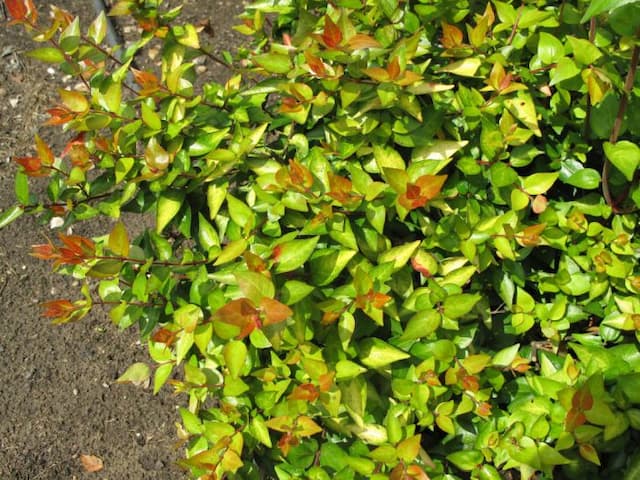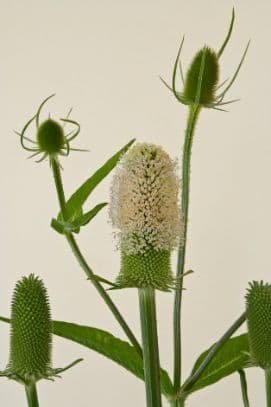Honeysuckle Lonicera periclymenum 'Belgica'

ABOUT
Lonicera periclymenum 'Belgica', commonly known as Early Dutch Honeysuckle, is a deciduous or sometimes semi-evergreen twining climber. The plant is adorned with oval, pointed leaves that appear in opposing pairs along the stems. Leaves typically emerge as a soft, fresh green hue and may remain on the plant until fall in milder climates. The most striking feature of the Early Dutch Honeysuckle are its flowers. The plant produces long, tubular blossoms that are elegantly curved, resembling the traditional trumpet shape associated with honeysuckles. These flowers come in a fusion of colors, with the exterior being a deep pink to red shade, maturing to a creamy yellow on the inside. The blooms exude a strong and sweet fragrance, especially in the evenings, attracting pollinators like bees, butterflies, and hummingbirds. Flowering begins in late spring or early summer, with the blossoms arranged in whorled clusters at the tips of the branches. Following the flowers, the honeysuckle may produce small, red to orange berries, which are popular with local bird species but are considered inedible for humans. The display of the Early Dutch Honeysuckle can be particularly appealing for gardeners who wish to add vertical interest or to mask fences and walls with its vigorous and abundant foliage. With its attractive flowers and the bonus of a heady scent, this plant is a favorite for gardeners seeking to create a wildlife-friendly environment or for those who simply enjoy the aromatic and visual pleasures it provides.
About this plant
 Names
NamesSynonyms
Early Dutch Honeysuckle, Woodbine
Common names
Lonicera periclymenum 'Belgica'.
 Toxicity
ToxicityTo humans
Honeysuckle may cause mild stomach upset if ingested by humans. Although not considered highly toxic, some species of honeysuckle contain saponic and cyanogenic glycosides which can cause mild to moderate symptoms upon ingestion. Symptoms of honeysuckle poisoning can include stomach pain, diarrhea, nausea, and vomiting. Ingesting large amounts can potentially lead to more severe symptoms, so it is advised to avoid consuming any part of the plant.
To pets
Honeysuckle can be harmful to pets if ingested. While not typically considered highly toxic, the plant does contain compounds like saponins and, in some species, cyanogenic glycosides, which can cause gastrointestinal upset in animals. Symptoms of poisoning in pets may include vomiting, diarrhea, abdominal pain, and in severe cases, more serious symptoms could develop. Pet owners should prevent their animals from eating any part of the honeysuckle plant.
 Characteristics
CharacteristicsLife cycle
Perennials
Foliage type
Deciduous
Color of leaves
Green
Flower color
Mixed
Height
6 feet (1.83 meters)
Spread
6 feet (1.83 meters)
Plant type
Climber
Hardiness zones
5
Native area
Europe
Benefits
 General Benefits
General Benefits- Attracts Pollinators: The honeysuckle 'Belgica' produces sweetly-scented flowers that draw in bees, butterflies and other beneficial insects, aiding plant pollination in your garden.
- Aesthetic Appeal: With its vibrant, trumpet-shaped flowers and lush foliage, it adds visual interest and beauty to garden spaces.
- Fragrance: The plant emits a strong, pleasant fragrance that can enhance the sensory appeal of outdoor areas.
- Wildlife Friendly: It provides nectar for pollinators and can also offer shelter for various species of birds and small mammals.
- Versatility in Landscaping: The honeysuckle can be used in a variety of landscaping designs, including trellises, fences, and as ground cover.
- Shade Tolerance: It performs well in partial shade, making it suitable for planting under trees or on the shady side of buildings.
- Seasonal Interest: It provides year-round interest with flowers in late spring to early summer, and berries in the fall, which may also attract birds.
 Medical Properties
Medical Properties- Anti-inflammatory: Lonicera periclymenum, commonly known as honeysuckle, may possess anti-inflammatory properties that could help reduce inflammation.
- Antibacterial: This plant has traditionally been used for its antibacterial effects, which might help in fighting certain bacterial infections.
- Antiviral: Honeysuckle is thought to have antiviral capabilities and could be beneficial in combating viral infections.
- Antioxidant: The antioxidants present in honeysuckle might help in neutralizing harmful free radicals in the body.
- Soothing agent: It has been used to soothe sore throats and respiratory conditions in traditional medicinal practices.
 Air-purifying Qualities
Air-purifying QualitiesThis plant is not specifically known for air purifying qualities.
 Other Uses
Other Uses- Floral arrangements - Lonicera periclymenum 'Belgica', commonly known as honeysuckle, features highly fragrant blooms that add a sweet aroma and a touch of wild beauty to bouquets and floral displays.
- Garden architecture - Climbing varieties of honeysuckle, such as 'Belgica', can be trained over pergolas, trellises, and archways, providing an aesthetic feature and shade in garden design.
- Wildlife attraction - This plant is particularly attractive to pollinators, such as bees and butterflies, as well as birds, providing a haven for wildlife in the garden.
- Edible blooms - The flowers of some honeysuckle varieties are edible and can be used to decorate desserts or infuse syrups, although 'Belgica' should be researched specifically for edibility and safe use before consumption.
- Natural fencing - Honeysuckle can be used to create a living fence, offering a more natural alternative to wooden or metal fencing and providing privacy once established.
- Bonsai - With appropriate care, honeysuckle can be trained as a bonsai plant, offering a fragrant and flowering option for enthusiasts of the art.
- Photography - The picturesque flowers of honeysuckle make it a popular subject for garden and nature photographers, capturing the essence of spring and early summer.
- Nectar source for homemade beverages - The nectar from honeysuckle blooms can be harvested to sweeten homemade iced teas and lemonades.
- Art inspiration - Honeysuckle's twisting vines and vibrant flowers have inspired artists and can be used as subject matter in various forms of art such as painting and textile design.
- Dye production - Although not commonly known for this use, the natural pigments of honeysuckle flowers and berries can potentially be used to create plant-based dyes for fabrics or crafts.
Interesting Facts
 Feng Shui
Feng ShuiThe Honeysuckle is not used in Feng Shui practice.
 Zodiac Sign Compitability
Zodiac Sign CompitabilityThe Honeysuckle is not used in astrology practice.
 Plant Symbolism
Plant Symbolism- Love and Devotion: The honeysuckle is often associated with feelings of affection and the everlasting bonds between loved ones, reflecting the plant's tendency to twine around structures.
- Generosity: With its abundant and sweet-smelling flowers, honeysuckle symbolizes the generosity of nature and the idea of giving without expecting anything in return.
- Protection: Honeysuckle can symbolize safety, as it often forms a dense thicket that can serve as a shelter for birds and small creatures.
- Nostalgia: The strong fragrance and the common presence of honeysuckle in many childhood areas can evoke a sense of nostalgia and fond memories of the past.
- Friendship: Because the honeysuckle plants can cling to various surfaces, they are sometimes seen as a symbol of the bonds of friendship and the support friends provide for each other.
- Happiness: The sweet scent and the lively colors of the flowers are believed to bring happiness and positivity to any environment, making it a symbol of joy.
 Water
WaterThe Early Dutch Honeysuckle requires watering when the top inch of soil feels dry, typically once a week. It's important to water deeply and thoroughly, allowing water to reach the roots, which might mean using approximately 1 to 1.5 gallons per plant for mature shrubs. During hot, dry spells, increase watering frequency to twice a week to ensure the soil doesn't dry out completely. In winter, reduce watering as the plant goes dormant and requires less moisture. Ensure good drainage to prevent waterlogging, as this can lead to root rot.
 Light
LightEarly Dutch Honeysuckle thrives best in full sun to partial shade. Ideally, it should receive at least 6 hours of sunlight a day, which promotes the best growth and flowering. An optimal spot would be one where the plant gets morning sunlight and some afternoon shade, especially in hotter climates to prevent scorching.
 Temperature
TemperatureEarly Dutch Honeysuckle is hardy and can tolerate a range of temperatures, but it performs best in temperate climates. It can survive minimum winter temperatures down to around 14 degrees Fahrenheit but may drop leaves if temperatures fall below this. The ideal growing temperatures are between 60 to 75 degrees Fahrenheit during the growing season.
 Pruning
PruningEarly Dutch Honeysuckle should be pruned to maintain shape, encourage new growth, and improve air circulation. The best time to prune is late winter or early spring, before new growth begins. Remove any dead, damaged, or excessively tangled branches, and cut back about one-third of the older stems to promote new, vigorous growth. Pruning can be done annually or every few years, depending on the plant's performance and desired appearance.
 Cleaning
CleaningAs needed
 Soil
SoilThe Early Dutch Honeysuckle thrives in well-draining soil rich in organic matter with a pH ranging from 5.5 to 8. A mix containing loam, garden compost, and a small amount of sand or perlite would be ideal to facilitate proper drainage and retain adequate moisture.
 Repotting
RepottingEarly Dutch Honeysuckle, being mostly cultivated outdoors and known for its hardiness, does not require frequent repotting. However, if grown in containers, consider repotting every 2-3 years to refresh the soil and accommodate root growth.
 Humidity & Misting
Humidity & MistingEarly Dutch Honeysuckle prefers moderate humidity levels but is quite adaptable to various environmental conditions. It is tolerant of both dry and humid climates, although extremely high humidity can promote fungal diseases.
 Suitable locations
Suitable locationsIndoor
Place Early Dutch Honeysuckle near a window with bright, indirect light.
Outdoor
Plant in well-draining soil, full sun to partial shade.
Hardiness zone
4-9 USDA
 Life cycle
Life cycleThe life of Lonicera periclymenum 'Belgica', commonly known as Early Dutch Honeysuckle, begins with seed germination, which requires a period of cold stratification to break dormancy. Once germinated, the young seedling establishes itself, producing a set of true leaves and developing a root system. As it matures, the plant enters a vegetative stage characterized by vigorous vine growth and the development of foliage. After reaching maturity, which can take a couple of years, it progresses to the reproductive stage, where it starts to produce fragrant flowers in late spring through to summer, attracting pollinators such as bees and butterflies. Following pollination, flowers develop into small red berries, the seeds within dispersed by birds and other animals. In autumn, Lonicera periclymenum 'Belgica' typically enters a period of dormancy, with leaves dropping as it conserves energy for the next growing season.
 Propogation
PropogationPropogation time
Early spring
The Lonicera periclymenum 'Belgica', commonly known as Early Dutch Honeysuckle, is typically propagated by semi-hardwood cuttings. The best time to take these cuttings is during late summer. To propagate by this method, a gardener would select a healthy, non-flowering stem and cut a segment approximately 6 inches (15 centimeters) in length. The lower leaves are removed, and the cut end can be dipped in rooting hormone to encourage root development. The cutting is then planted in a well-draining soil mixture, with the bottom half of the cutting buried. It should be placed in a warm, shaded area and kept consistently moist. Roots usually develop within a few weeks, after which the new plant can be gradually acclimatized to more sunlight and eventually transplanted to its final location.








